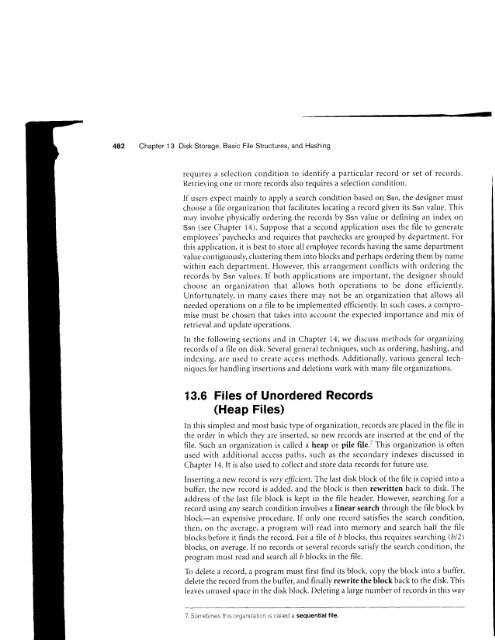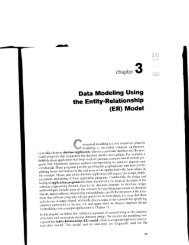13.1 through 13.5, 13.10 and 13.11
13.1 through 13.5, 13.10 and 13.11
13.1 through 13.5, 13.10 and 13.11
Create successful ePaper yourself
Turn your PDF publications into a flip-book with our unique Google optimized e-Paper software.
Chapter 13 Disk Storage, Basic File Structures, <strong>and</strong> Hashingrequires a selection condition to identifo a particular record or set of records.Retrieving one or more records also requires a selection condition.If users expect mainly to apply a search condition based on Ssn, the designer mustchoose a file organization that facilitates locating a record given its Ssn value. Thisrray involve physically ordering the records try Ssn vaiue or defining an index onSsn (see Chapter l4). Suppose that a second application uses the file to generateemployees'paychecks <strong>and</strong> requires that paychecks are grouped by departnent. Forthis application, it is best to store all empioyee records having the s:rme departmentvalue contiguously, clustering them into blocks <strong>and</strong> perhaps ordering them by namewithin each department. However, this arrangement conflicts with ordering therecords by Ssn values. Ii both applications are important, the designer shouldchoose an organization that allows both operations to be clone efTiciently.UnfortunatelS in rnany cases there may not be an organization that allows allneeded operations on a file to be implemented efficiently. In such cases, a compromisemust be chosen that takes into account the expected importance <strong>and</strong> mix ofretrieval <strong>and</strong> update operations.In the follorvir.rg sections <strong>and</strong> in Chapter 14, we discuss methods for organizingrecords of a file on disk. Several ger.reral techniques, such as ordering, hashing, <strong>and</strong>indexing, are used to create access methods. Additionally, various general techr.riquesfor h<strong>and</strong>ling insertions <strong>and</strong> deletions work with many file organizations.13.6 Files of Unordered Records(Heap Files)In this simplest <strong>and</strong> most basic type of organization, records are placed in the file inthe order in which they are inserted, so new records are inserted at the end of thefile. Such an organization is called a heap or pile fi1e.7 This organization is oftenused rvith additional access paths, such irs the secondary indexes discussed inChapter 14. It is also used to collect irnd store data records for future use.lnserting a new record is very eficienr. The last disk block of the file is copied into abuffer, the new record is added, <strong>and</strong> the block is then rewritten back to disk. Theaddress of the last file block is kept in the file header. Howel'er, searching for arecord using any search condition involves a linear search <strong>through</strong> the file block byblock-an expensive procedure. If only one record satisfies the search condition,then, on the average, a prograrn will read into tnemory <strong>and</strong> search half the fileblocks before it finds the record. For a file of b blocks, this requires searching (b/2)blocks, on average. If no records or several records satisfy the search condition, theprogram must read <strong>and</strong> search all b blocks in the file.To delete a record, a program must first find its block, copy the block into a buffer,delete the record from the buffer, <strong>and</strong> finally rewrite the block back to the disk. Thisleaves unused space in the disk block. Deleting a large number of records in this way7 Sometrmes this organizatron is called a sequential file.














